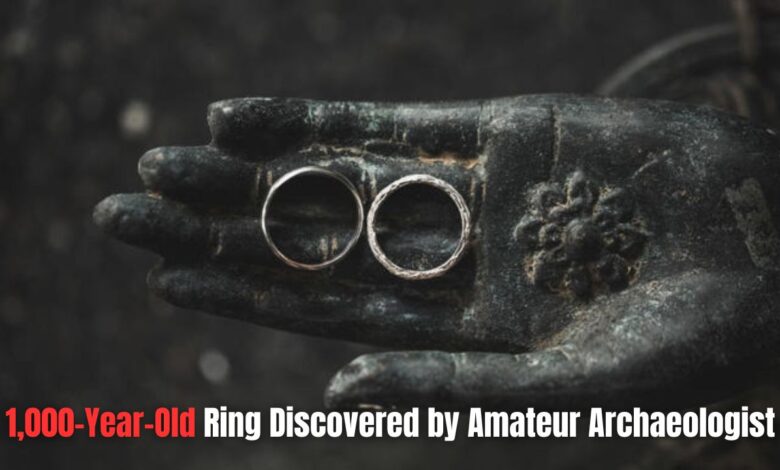1,000-Year-Old Ring Discovered by Amateur Archaeologist

The discovery of a 1,000-year-old ring by an amateur archaeologist has captivated both experts and the public, shedding light on ancient craftsmanship and offering profound implications for understanding history. This unexpected find is not just a rare artifact but a window into the life and culture of civilizations that once thrived long ago. The importance of this discovery cannot be overstated, as it represents a significant contribution to the field of archaeology and historical research.
The Discovery of the 1,000-Year-Old Ring
Amateur archaeologists, often driven by personal passion and curiosity, occasionally make astonishing discoveries that reshape historical narratives. In this case, the 1,000-year-old ring, found unexpectedly by a hobbyist using a metal detector, is one such example. This find occurred in a region known for its rich historical significance, and the ring’s age places it within a fascinating period of ancient history, possibly dating back to the Viking Age or the early Middle Ages.
How the Ring Was Found
The discovery of the ring was purely accidental. The archaeologist was conducting a routine search in an area previously deemed unremarkable. However, when the detector signaled the presence of a metallic object buried beneath the surface, the individual uncovered what would later be recognized as a 1,000-year-old treasure. The ring’s condition, though worn, remains largely intact, offering valuable insight into ancient metallurgy and design techniques.
The Craftsmanship and Design of the Ancient Ring
Upon closer examination, the craftsmanship of the ring reveals extraordinary skill and precision. The design is both intricate and symbolic, indicating the object may have held significant meaning to its owner. Experts speculate that the ring could have been a status symbol, worn by someone of considerable wealth or influence, possibly a member of the nobility or an individual with ties to important trade routes.
Materials Used in the Ring
The ring is believed to have been crafted from precious metals, such as silver or gold, and may also feature gemstones. Such materials were not only rare but were often indicative of an individual’s power and social standing. The ring’s preservation over a millennium speaks to the high quality of the materials used and the expertise of the craftsman responsible for its creation.
Cultural and Historical Significance of the Find
This discovery has important historical implications that extend beyond the object itself. The period in which the ring was made coincides with key developments in medieval society, including the rise of powerful kingdoms, the expansion of trade, and the spread of cultural and religious ideas across Europe and other regions. This ring offers a tangible connection to that era, providing archaeologists and historians with fresh material to analyze.
Implications for Our Understanding of Trade and Society
The location of the find is particularly significant. The ring’s discovery in a region far from the centers of ancient power suggests that trade routes may have extended further than previously thought. This reinforces the idea that ancient societies were more interconnected than historians once believed, and the movement of goods, ideas, and people played a crucial role in shaping the ancient world.
The Role of Amateur Archaeology in Historical Discoveries
Amateur archaeologists have long contributed to the field by making remarkable finds in areas that professional archaeologists might not explore. These discoveries often emerge from the enthusiasm and dedication of individuals fascinated by history, such as the archaeologist who found this 1,000-year-old ring. Their work, though often undervalued, has led to important breakthroughs and has proven to be a valuable asset in understanding the past.
Challenges Faced by Amateur Archaeologists
While amateur archaeologists can make significant discoveries, they also face challenges. Many of them lack formal training in handling or preserving artifacts, and sometimes these valuable pieces of history are accidentally damaged during excavation. In the case of the 1,000-year-old ring, the discoverer was fortunate that the artifact remained largely undamaged, ensuring it could be studied in detail by professionals.
Expert Analysis of the 1,000-Year-Old Ring
Since the discovery, the ring has undergone extensive analysis by experts in the field. Using advanced tools like X-ray fluorescence (XRF) and radiocarbon dating, researchers have been able to determine the ring’s exact age and origin. Preliminary results suggest the ring may have been produced in the early medieval period, somewhere between the 9th and 11th centuries, offering a direct link to a world that is now long gone.
What Experts Are Saying
Archaeologists are particularly excited about the find, as the 1,000-year-old ring offers valuable insights into early medieval societies. It is rare for such an artifact to be discovered intact, and its design provides clues about the artistic and cultural values of the time. Furthermore, the craftsmanship evident in the ring challenges previous assumptions about the technological capabilities of medieval artisans.
Preservation and Display of the Artifact
Once the analysis is complete, it is expected that the 1,000-year-old ring will be displayed in a museum where it can be admired by the public and studied by historians. Proper conservation techniques will ensure that the ring is preserved for future generations, allowing it to remain a key piece of evidence in the ongoing exploration of medieval history.
Future Research and Excavation in the Area
Given the significance of this find, archaeologists are now planning more extensive excavations in the region where the ring was discovered. There is hope that other artifacts may be unearthed, further enriching our understanding of the past and providing additional context for the 1,000-year-old ring. These efforts may shed light on the daily lives, beliefs, and interactions of ancient peoples who lived in the area.
Conclusion: The Impact of This Discovery on Archaeology
The discovery of the 1,000-year-old ring is a testament to the importance of archaeological exploration, both amateur and professional. This find has opened new avenues for research, offering a fresh perspective on ancient societies and their complexities. While we may never know the full story behind the ring, its existence speaks to a rich and dynamic past that continues to inspire curiosity and awe.




